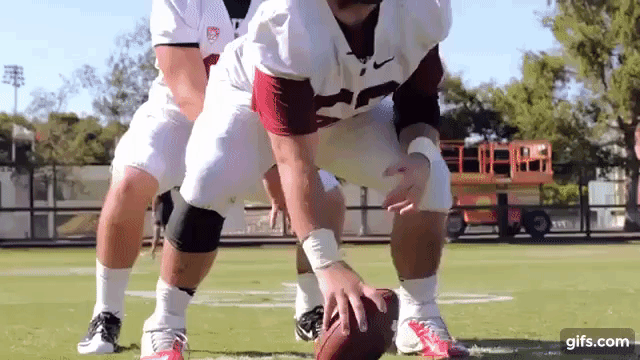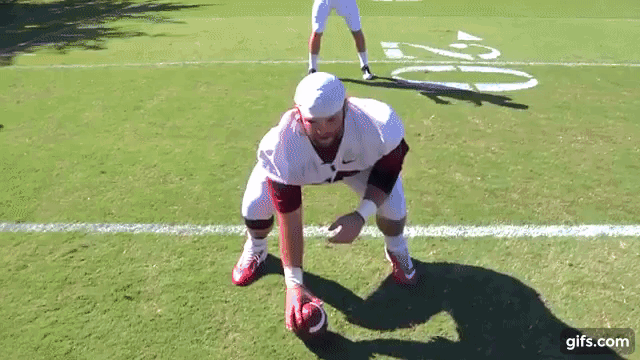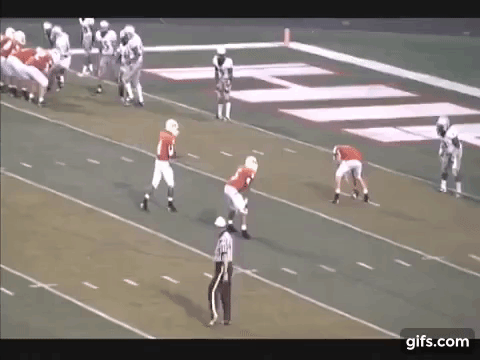The exchange from the center to the quarterback is one of the most critical elements to start a play. It allows receivers, running backs, and lineman to initiate contact.
A football snap is when the center successfully either hands the ball off between his legs or throws it between his legs, otherwise known as a shotgun snap. The snap from center to the quarterback is the most important transition in the game, as it starts the play.
Snapping the football has been around since the inception of the game. It requires one player to softly toss it to another player, which officially allows the offensive players to move. Just as important ball security is to a running back, the exchange from the center to the quarterback is equally important.
In this article, we’re going to examine the different types of football snaps and how to get in the proper stance for an offensive lineman.
Once the center has moved the ball off of the ground, the play has officially begun. Defensive players are able to cross the line of scrimmage and tackle the ball carrier.
Let’s look at different types of football snaps:
Fundamentals Of Snapping A Football
In this portion of the blog, we’re going to examine how players snap the football and the variety of snaps used throughout the game. If you’re looking for a more in-depth breakdown and simplistic tutorial, we’ve created a Complete Football Guide to help you learn.
The first 2 you’ll see almost every game, whether it be on offense or special teams. The last one is pretty rare.
1 Hand Between The Legs
Between the legs snap is the most common type of snap. It requires the players to put the ball through their legs and successfully deliver it to the quarterback. Types of football snaps from this position are the under center snap and the shotgun snap.

The shotgun snap is similar to the regular snap, except the player will let go of the football as he’s moving his hand through his legs. As shown below, the center has a pretty big responsibility having to snap the football, move his feet, and effectively block the person in front of him. The shotgun snap has become a large part of the present-day passing game.

2 Hand Between The Legs
This snap is often seen on special teams. Teams often choose to bring a long snapper (different from their center) and long snap the football 10-15 yards on punts and around 5-7 yards on field goals.

Rules have been put in place both and the high school and the college level that protect the center from getting hit when the snap is over 7 yards.
This is why teams often choose to bring in a smaller player, to just snap and not worry about blocking.
Swinging Gate Snap
This type of snap is very rare and is often seen on 2 point conversions. The ball doesn’t necessarily need to go between a player's legs.
It can be thrown to the side, as long as the snap moves backward to an eligible player. Teams will often use this type of snap to throw the ball behind a wall of players which can barrel forward for a first down.

This play is often found in 2 point play situations, where teams will utilize the short field and spread formation to attack the side (whether it be left , right or even up the middle, like shown above) that is weakest.
As mentioned this snap is hardly done, but when executed properly, can be effective to snap in different directions.
Different Types of Football Snaps
On every single play (outside of a kickoff or free kick) there is a snap of some type to begin the play. Before we can even get to our advanced plays, We need to understand how the ball can be snapped.
Above we learned how to fundamentally snap the football. Now let’s learn the different types of football snaps that can occur on each play. Here are the types of football snaps we’ll cover:
Under Center Snap
The traditional snap is the most basic Quarterback-Center exchanges. It is the first type taught at a Pee-Wee football level and it is used at every level of football.
The Quarterback lines up under the Center and readies himself for the snap. The Center snaps the ball, bends his wrist and delivers directly into the hands of his Quarterback. See the GIF below:

Shotgun Snap
As offenses began to emphasize the passing attack, the ‘Shotgun’ formations began to become a major part of how the game is played.
This involves the Quarterback moving a few yards back behind the center. For the Center to snap the ball, he will now have to toss the ball through the air and reach his Quarterback. Below is a clip of how this snap looks:

This snap is common in most levels of football. The Center has a good grip on the ball and does his best to have a tight spiral in his snap. A good spiral makes it easy for the Quarterback to catch it and throw it himself.
Dead Ball Shotgun Snap
Shotgun snaps are starting to become the primary snap for more college and NFL teams. As expected, coaches have found a way to maximize how the ball is delivered to the quarterback.
The “Dead Ball” snap can replace the Shotgun snap.
The Center snaps the ball through his legs to reach the quarterback, like a regular shotgun snap. However, there is no spiral.
The ball is flipped back to the Quarterback who must grab the snap and then re-adjust the ball in his hands so he has a proper grip. This small change allows other linemen to play the Center position without worrying about getting the technique of the traditional shotgun snaps mastered.
This should also minimize the chance of an errant snap. With no spiraling technique in the wrist, the center does a pendulum-like action backward which has a smaller chance of error.
Due to this fact, this snap has become more and more popular this decade.